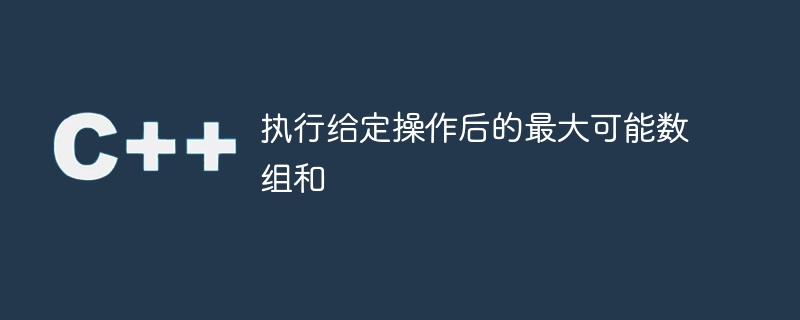
在这个问题中,我们将对数组元素执行给定的操作,并找到最后的最大和。
在这里,每次操作中,我们可以从数组中最多选择X[p]个元素,并用Y[p]个元素替换它们,以最大化总和。
在简单的方法中,我们将找到X[p]数组元素,这些元素小于Y[p]元素,并将其替换为Y[p]。
在高效的方法中,我们将使用优先队列来获取最大的总和。
问题陈述− 我们给定了包含N个数字的nums[]数组。同时,我们给定了包含M个整数的X[]和Y[]数组。我们需要对nums[]数组执行以下操作。
我们需要对X[]和Y[]元素的每个元素执行M次操作。在每次操作中,我们需要从数组nums[]中选择最大的X[p]元素,并将其替换为Y[p]。
给定的任务是在执行M次操作后找到nums[]数组元素的最大和。
示例示例
输入
nums[] = {10, 8, 7, 60, 20, 18, 30, 60}; m = 3; x[] = {1, 2, 5}; y[] = {500, 10, 2};
输出
708
Explanation − 让我们逐个执行每个操作。
在第一次操作中,我们将用500替换7个元素。所以,数组变为 {10, 8, 500, 60, 20, 18, 30, 60}。
在第二次操作中,我们最多可以用10替换2个元素,但我们只有1个小于10的元素。所以,我们将8替换为10,数组变为{10, 10, 500, 60, 20, 18, 30, 60}。
在第三个操作中,我们最多可以用2替换5个元素,但数组中没有任何小于2的元素。因此,我们不会替换任何元素。
输入
nums[] = {30, 40, 50, 50, 60}; m = 3; x[] = {2, 3, 6}; y[] = {10, 8, 21};
输出
230
解释 − y[]数组的所有元素都小于原数组的元素。因此,我们不需要替换给定数组的任何元素来获得最大的和。
输入
nums[] = {30, 40, 50, 50, 60}; m = 3; x[] = {2, 4, 5}; y[] = {50, 60, 100};
输出
500
Explanation − 在这里,我们可以在每次操作中最多替换x[p]个元素。在最后一次操作中,我们可以将数组中的每个元素替换为100,从而得到最大和等于100。
方法一
在这种方法中,我们将遍历x[]和y[]数组。在每次迭代中,我们将对数组进行排序,以获取最多x[p]个小于y[p]元素的数组元素,并用y[p]替换它们。
算法
步骤 1 − 将‘maxSum’初始化为0,用于存储数组元素的最大和。
步骤2 − 开始遍历x[]和y[]数组元素。
步骤 3 − 将 x[p] 的值存入临时变量,并对 nums[] 数组进行排序。
第四步− 在循环内开始遍历已排序的数组。
步骤 5 − 如果温度大于0,并且 nums[q] 小于 y[p],则使用 y[p] 更新 nums[q],并将 temp 值减1。
第6步− 在循环之外,开始遍历更新后的数组,将所有数组元素的和取出并存储到maxSum变量中。
第7步 − 在函数结束时返回maxSum。
示例
#include <bits/stdc++.h>
using namespace std;
int getMaxSum(int nums[], int n, int q, int x[], int y[]) {
int maxSum = 0;
// Traverse X[] and Y[] array
for (int p = 0; p < q; p++) {
// Replacing x[p] number of elements of nums[] array with y[p] if they are lesser than y[p]
int temp = x[p];
sort(nums, nums + n);
for (int q = 0; q < n; q++) {
if (temp > 0 && nums[q] < y[p]) {
nums[q] = y[p];
temp--;
}
}
}
// Sum of the array
for (int p = 0; p < n; p++) {
maxSum += nums[p];
}
return maxSum;
}
int main() {
int nums[] = {10, 8, 7, 60, 20, 18, 30, 60};
int n = (sizeof nums) / (sizeof nums[0]);
int m = 3;
int x[] = {1, 2, 5};
int y[] = {500, 10, 2};
cout << "The maximum sum we can get by replacing the array values is " << getMaxSum(nums, n, m, x, y);
return 0;
}
输出
The maximum sum we can get by replacing the array values is 708
时间复杂度− O(M*NlogN),其中O(M)用于遍历所有查询,O(NlogN)用于对数组进行排序。
空间复杂度− 对于对数组进行排序,空间复杂度为O(N)。
方法二
在这种方法中,我们将使用优先队列来存储数组元素和其出现次数的配对。
例如,我们将为每个数组元素将{nums[p],1}对推入优先队列。同时,我们将{y[p],x[p]}对推入优先队列。在优先队列中,对将根据第一个元素进行排序。因此,我们可以从队列中取出最高的N个元素。在这里,对于{y[p],x[p]}对,我们可以取出y[p]元素x[p]次,并且我们需要取出总共N个元素以最大化总和。
算法
Step 1 − Initialize the ‘maxSum’ with 0 and the priority queue to store the pair of elements and their number of occurrences.
第二步− 对于所有的数组元素,将{nums[p], 1}对插入队列中。
步骤 3 − 然后,将 {y[p], x[p]} 对插入优先队列中。
第四步− 迭代直到 n 大于 0。
步骤 4.1 − 从优先队列中取出第一个元素。
步骤 4.2 − 将 first_ele * max(n, second_ele) 添加到总和中。这里,我们使用 max(n, second_ele) 来处理最后一种情况。
步骤 4.3 − 从 n 中减去 second_ele。
第5步− 返回maxSum。
示例
#include <bits/stdc++.h>
using namespace std;
int getMaxSum(int nums[], int n, int m, int x[], int y[]) {
int maxSum = 0, p;
// To get maximum sum
priority_queue<pair<int, int>> p_que;
// Insert nums[] array pairs into the queue
for (p = 0; p < n; p++)
p_que.push({nums[p], 1});
// Push replacement pairs
for (p = 0; p < m; p++)
p_que.push({y[p], x[p]});
// Add the first N elements of the priority queue in the sum
while (n > 0) {
// Get top element of priority queue
auto temp = p_que.top();
// Remove top element
p_que.pop();
// Add value to the sum
maxSum += temp.first * min(n, temp.second);
// Change N
n -= temp.second;
}
return maxSum;
}
int main() {
int nums[] = {10, 8, 7, 60, 20, 18, 30, 60};
int n = (sizeof nums) / (sizeof nums[0]);
int m = 3;
int x[] = {1, 2, 5};
int y[] = {500, 10, 2};
cout << "The maximum sum we can get by replacing the array values is " << getMaxSum(nums, n, m, x, y);
return 0;
}
输出
The maximum sum we can get by replacing the array values is 708
时间复杂度 - O(N*logN + m*logm),其中O(N)和O(m)用于遍历给定的数组,O(logN)用于插入和删除队列中的元素。
空间复杂度 - O(N+M),用于将对存储到队列中。
<p>在第一种方法中,我们需要在每次迭代中对数组进行排序,以找到最小的x[p]个元素。使用优先队列在插入或删除元素时自动对元素进行排序,因为它使用了堆数据结构。因此,它可以提高代码的性能。</p>


